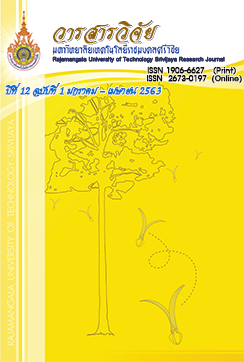การออกแบบและสร้างชุดการทดลองการแทรกสอดของเสียงภายในท่อร่วมกับแอปพลิเคชันสมาร์ตโฟน
คำสำคัญ:
การแทรกสอดแบบเสริมกัน, คลื่นเสียง, สมาร์ตโฟน, ชุดทดลองบทคัดย่อ
บทความนี้นำเสนอชุดทดลองการแทรกสอดของคลื่นเสียงโดยมีวัตถุประสงค์เพื่อออกแบบและพัฒนาชุดทดลองการแทรกสอดของเสียงได้อย่างถูกต้องตรงตามทฤษฎีเรื่อง การแทรกสอดของเสียงใช้แอปพลิเคชันสมาร์ตโฟน(Hoel Boedec)สร้างคลื่นเสียงที่มีความถี่เสียง ในช่วง 600-1200 เฮิรตซ์ โดยชุดทดลองสร้างจากท่อ PVC สามารถปรับเปลี่ยนให้มีความยาวของท่อเพื่อศึกษาค่าผลต่างของทางเดินเสียง (path difference) ระหว่างคลื่นเสียงสองขบวน เมื่อนำชุดทดลองไปทดสอบหาค่าความยาวคลื่นเสียงที่อุณหภูมิห้อง โดยสังเกตจากการแทรกสอดของเสียงแบบเสริมกันผ่านแอปพลิเคชันสมาร์ตโฟน(Advanced spectrum Analyzer PRO) เมื่อปล่อยความถี่ที่ 600-1200 เฮิรตซ์ โดยมีค่าที่วัดความถี่ได้จาก smartphones คือ 602, 710, 796, 904, 1000, 1100 และ 1200 เฮิรตซ์ โดยมีค่าความคลาดเคลื่อนเฉลี่ยเป็น 7.2 เปอร์เซ็นต์ ส่วนการแทรกสอดแบบหักล้างกันผ่านสมาร์ตโฟน ซึ่งปล่อยความถี่เช่นเดียวกับการแทรกสอดแบบเสริมและมีค่าที่วัดความถี่ได้จาก smartphones เท่ากัน โดยมีค่าความคลาดเคลื่อนเฉลี่ยเป็น 12.8 เปอร์เซ็นต์ และจากผลการทดลองพบว่า ความถี่จะแปรผกผันกับความยาวคลื่น สาเหตุที่ทำให้เกิดความคลาดเคลื่อนอาจเกิดจากเครื่องปล่อยความถี่ไม่ได้ปล่อยความถี่ตามที่กำหนด และเครื่องรับสัญญาณความถี่มีคลื่นเสียงจากภายนอกรบกวนจึงส่งผลให้เกิดความคลาดเคลื่อนได้ จากที่กล่าวมาข้างต้นเมื่อความถี่เพิ่มขึ้น ความยาวคลื่นจะลดลง ข้อเสนอแนะในการทำวิจัยในครั้งนี้โรงเรียนควรนำชุดทดลองการแทรกสอดของเสียงนี้ไปเป็นต้นแบบเพื่อผลิตขึ้นใช้ได้เองในห้องปฏิบัติการฟิสิกส์ เนื่องจากวัสดุอุปกรณ์ต่าง ๆ สามารถจัดหาได้ง่าย มีวิธีการสร้างไม่ยุ่งยากซับซ้อน และให้ผลการทดลองชัดเจน
เอกสารอ้างอิง
ชาติ ทีฆะ. 2561. การประยุกต์ใช้สมาร์ตโฟนเซนเซอร์สำหรับการทดลองฟิสิกส์. พิมพ์ครั้งที่ 1. ศูนย์บริการสื่อและสิ่งพิมพ์กราฟฟิคไซท์, กรุงเทพฯ.
วันธนา ศิลปะวิลาวัณย์. 2552. ชุดการทดลองเพื่อแก้ไขแนวคิดที่คลาดเคลื่อนของเรื่องคลื่นเสียง. วิทยานิพนธ์ ปริญญาวิทยาศาสตรมหาบัณฑิต, มหาลัยเชียงใหม่.
สุระ วุฒิพรหม และ พนัส แก่นอาสา. 2554. การสำรวจตรวจสอบแนวคิดที่คลาดเคลื่อนเรื่องคลื่นกลของนักเรียนชั้นมัธยมศึกษาปีที่ 4. กระทรวงวิทยาศาสตร์และเทคโนโลยี, กรุงเทพฯ.
อรณัฏฐ์ สุริยะพิชิตกุล. 2559. การออกแบบและสร้างชุดทดลองการแทรกสอดของเสียง โดยใช้แหล่งกำเนิดเสียงจากแอปพลิเคชันของสมาร์ตโฟน. วิทยานิพนธ์ปริญญาการศึกษามหาบัณฑิต สาขาฟิสิกส์ศึกษา, มหาวิทยาลัยบูรพา.
อรพินท์ ชื่นชอบ. 2549. การพัฒนาผลสัมฤทธิ์ทางการเรียนฟิสิกส์และความสามารถในการแก้ปัญหาทาง ฟิสิกส์ของนักเรียนชั้นมัธยมศึกษาปีที่ 4 ด้วยวิธีสอนแบบสืบเสาะหาความรู้ โดยเสริมการแก้ปัญหา ตามเทคนิคของโพลยา.
วิทยานิพนธ์ปริญญาการศึกษามหาบัณฑิต สาขาหลักสูตรและการสอน, มหาวิทยาลัยบูรพา.
Parolin, S. and Pezzi, G. 2015. Kundt’s tube experiment using smartphones. Physics Education 50(1): 443-447.
ดาวน์โหลด
เผยแพร่แล้ว
รูปแบบการอ้างอิง
ฉบับ
ประเภทบทความ
สัญญาอนุญาต
เนื้อหาและข้อมูลในบทความที่ลงตีพิมพ์ในวารสารวิจัยมหาวิทยาลัยเทคโนโลยีราชมงคลศรีวิชัย ถือเป็นข้อคิดเห็นและความรับผิดชอบของผู้เขียนบทความโดยตรง ซึ่งกองบรรณาธิการวารสารไม่จำเป็น ต้องเห็นด้วย หรือร่วมรับผิดชอบใดๆ
บทความ ข้อมูล เนื้อหา รูปภาพฯลฯ ที่ได้รับการตีพิมพ์ในวารสารวิจัย มหาวิทยาลัยเทคโนโลยีราชมงคลศรีวิชัย ถือเป็นลิขสิทธ์ของวารสารวิจัย มหาวิทยาลัยเทคโนโลยีราชมงคลศรีวิชัย หากบุคคลหรือหน่วยงานใดต้องการนำทั้งหมดหรือส่วนหนึ่งส่วนใดไปเผยแพร่ต่อหรือเพื่อการกระทำการใดๆจะต้องได้รับอนุญาตเป็นลายลักษ์อักษรจากวารสาร มหาวิทยาลัยเทคโนโลยีราชมงคลศรีวิชัยก่อนเท่านั้น







